Strain Localization at Constant Strain Rate and Changing Stress Conditions: Implications for Plate Boundary Processes in the Upper Mantle
Abstract
1. Introduction
2. Geological Background
2.1. Pyrenees
2.2. Turon de Técouère
3. Methods
3.1. Samples and Thin Section Preparation
3.2. Scanning Electron Microscopy and Electron Backscatter Diffraction Analysis
3.3. Paleopiezometry
3.4. 40Ar/39Ar Dating
4. Results
4.1. Microstructure and Grain Size within Mylonitic Domains
4.2. Olivine Crystallographic Preferred Orientations and Low-Angle Misorientations
4.2.1. Protomylonite
4.2.2. Ultramylonite
4.3. Olivine Subgrain Size and Dislocation Density
4.4. Differential Stress
4.4.1. Protomylonites
4.4.2. Mylonites
4.4.3. Ultramylonites
4.5. 40Ar/39Ar Analysis of Hornblende
5. Discussion
5.1. Deformation History of Ultramafic Massifs in Chainons Bernais Region of Northern Pyrenees
5.2. Deformation History of Peridotites along the Turon de Técouère Shear Zone
- 1.
- During Stage 1 (~1000 °C), a transition in grain size occurred across the zone from a coarse granular tectonite (preserved in the present-day protomolyonite domain) to a mylonite (preserved in polycrystalline porphyroclasts in the present-day ultramylonite domain) reflecting a strain gradient across the shear zone (Figure 8A, Stage 1). In this context, the present-day ultramylonite formed along a pre-existing, fine-grained mylonite [64].
- 2.
- During Stage 2 (~850 °C), grain size reduction by reaction was active throughout the shear zone (Figure 8A, Stage 2) resulting in the development of the fine-grained (~3 µm) polyphase matrix. This reaction-involved deformation progressed faster in the finer-grained domains of the shear zone [64], i.e., the mylonite of Stage 1.
5.3. Temperature–Stress–Strain Rate Path
5.3.1. Stage 1: ~1000 °C
5.3.2. Stage 2: ~850 °C
5.3.3. Stage 3: ~750 °C
5.3.4. Strain Rate and Stress Evolution
5.4. Localization as a Result of Grain-Size Sensitive Deformation Processes
5.5. Constant Strain-Rate Localization at a Plate Boundary
6. Conclusions
Supplementary Materials
Author Contributions
Funding
Data Availability Statement
Acknowledgments
Conflicts of Interest
References
- Kirby, S.H.; Kronenberg, A.K. Rheology of the lithosphere: Selected topics. Rev. Geophys. 1987, 25, 1219–1244. [Google Scholar] [CrossRef]
- Rutter, E.H.; Brodie, K.H. Experimental “syntectonic” dehydration of serpentinite under conditions of controlled pore water pressure. J. Geophys. Res. 1988, 93, 4907–4932. [Google Scholar] [CrossRef]
- Braun, J.; Chery, J.; Poliakov, A.; Mainprice, D.; Vauchez, A.; Tomassi, A.; Daignieres, M. A simple parameterization of strain localization in the ductile regime due to grain size reduction: A case study for olivine. J. Geophys. Res. 1999, 104, 25167–25181. [Google Scholar] [CrossRef]
- Montési, L.G.J.; Hirth, G. Grain size evolution and the rheology of ductile shear zones; from laboratory experiments to postseismic creep. Earth Planet. Sci. Lett. 2003, 211, 97–110. [Google Scholar] [CrossRef]
- Shea, W.T., Jr.; Kronenberg, A.K. Strength and anisotropy of foliated rocks with varied mica contents. J. Struct. Geol. 1993, 15, 1097–1121. [Google Scholar] [CrossRef]
- Handy, M.R. Rheological pathways in shear zones. Terra Abstr. 1990, 2, 14. [Google Scholar]
- Toy, V.G.; Newman, J.; Lamb, W.; Tikoff, B. The role of pyroxenites in formation of shear instabilities in the mantle; evidence from an ultramafic ultramylonite, Twin Sisters Massif, Washington. J. Petrol. 2010, 51, 55–80. [Google Scholar] [CrossRef][Green Version]
- Jordan, P. The rheology of polymineralic rocks: An approach. Geol. Rundschau 1988, 77, 285–294. [Google Scholar] [CrossRef]
- Goodwin, L.B.; Tikoff, B. Competency contrast, kinematics, and the development of foliations and lineations in the crust. J. Struct. Geol. 2001, 24, 1065–1085. [Google Scholar] [CrossRef]
- Tommasi, A.; Knoll, M.; Vauchez, A.; Signorelli, J.W.; Thoraval, C.; Loge, R. Structural reactivation in plate tectonics controlled by olivine crystal anisotropy. Nat. Geosci. 2009, 2, 423–427. [Google Scholar] [CrossRef]
- Drury, M.R.; Vissers, R.L.M.; Van der Wal, D.; Hoogerduijn Strating, E.H. Shear localisation in upper mantle peridotites. Pure Appl. Geophys. 1991, 137, 439–460. [Google Scholar] [CrossRef]
- Newman, J.; Lamb, W.M.; Drury, M.R.; Vissers, R.L.M. Deformation processes in a peridotite shear zone: Reaction-softening by an H2O-deficient, continuous net transfer reaction. Tectonophysics 1999, 303, 193–222. [Google Scholar] [CrossRef]
- Ogawa, M. Shear instability in a viscoelastic material as the cause of deep focus earthquakes. J. Geophys. Res. 1987, 92, 13801–13810. [Google Scholar] [CrossRef]
- Regenauer-Lieb, K.; Yuen, D.A.; Branlund, J. The initiation of subduction; criticality by addition of water? Science 2001, 294, 578–580. [Google Scholar] [CrossRef]
- Trepmann, C.A.; Stöckhert, B. Quartz microstructures developed during non-steady state plastic flow at rapidly decaying stress and strain rate. J. Struct. Geol. 2003, 25, 2035–2051. [Google Scholar] [CrossRef]
- Regan, S.P.; Williams, M.L.; Leslie, S.; Mahan, K.H.; Jercinovic, M.J.; Holland, M.E. The Cora Lake shear zone, Athabasca granulite terrane, an intraplate response to far-field orogenic processes during the amalgamation of Laurentia. Can. J. Earth Sci. 2014, 51, 877–901. [Google Scholar] [CrossRef]
- Campbell, L.R.; Menegon, L. Transient high strain rate during localized viscous creep in the dry lower continental crust (Lofoten, Norway). J. Geophys. Res. Solid Earth 2019, 124, 10240–10260. [Google Scholar] [CrossRef]
- Chatzaras, V.; Tikoff, B.; Kruckenberg, S.C.; Titus, S.J.; Teyssier, C.; Drury, M.R. Stress variations in space and time within the mantle section of an oceanic transform zone: Evidence for the seismic cycle. Geology 2020, 48, 569–573. [Google Scholar] [CrossRef]
- Norris, R.J. Strain localisation within ductile shear zones beneath active faults: The Alpine Fault contrasted with the adjacent Otago fault system, New Zealand. Earth Planets Space 2004, 56, 1095–1101. [Google Scholar] [CrossRef]
- Ford, H.A.; Fischer, K.M.; Lekic, V. Localized shear in the deep lithosphere beneath the San Andreas Fault system. Geology 2014, 42, 295–298. [Google Scholar] [CrossRef]
- Austrheim, H. Eclogitization of lower crustal granulites by fluid migration through shear zones. Earth. Planet. Sci. Lett. 1987, 81, 221–232. [Google Scholar] [CrossRef]
- Tikoff, B.; St. Blanquat, M. Transpressional deformation and changing kinematics in the Late Cretaceous Sierra Nevada magmatic arc, California. Tectonics 1997, 16, 442–459. [Google Scholar] [CrossRef]
- Schmalzle, G.; Dixon, T.; Malservisi, R.R. Govers Strain accumulation across the Carrizo segment of the San Andreas Fault, California: Impact of laterally varying crustal properties. J. Geophys. Res. 2006, 111, B05403. [Google Scholar] [CrossRef]
- Bystricky, M.; Kunze, K.; Burlini, L.; Burg, J.P. High shear strain of olivine aggregates: Rheological and seismic consequences. Science 2000, 290, 1564–1567. [Google Scholar] [CrossRef]
- Paterson, M.S. Localization in rate-dependent shearing deformation, with application to torsion testing. Tectonophysics 2007, 445, 273–280. [Google Scholar] [CrossRef]
- Hansen, L.N.; Zimmerman, M.E.; Dillman, A.M.; Kohlstedt, D.L. Strain localization in olivine aggregates at high temperature: A laboratory comparison of constant-strain-rate and constant-stress boundary conditions. Earth Planet. Sci. Lett. 2012, 333–334, 134–145. [Google Scholar] [CrossRef]
- ECORS Pyrenees Team. The ECORS deep reflection seismic survey across the Pyrenees. Nature 1988, 331, 508–511. [Google Scholar] [CrossRef]
- Choukroune, P. ECORS team. The ECORS Pyrenean deep seismic profile reflection data and the overall structure of an orogenic belt. Tectonics 1989, 8, 23–39. [Google Scholar] [CrossRef]
- Roure, F.; Choukroune, P.; Berastegui, X.; Munoz, J.A.; Villien, A.; Matheron, P.; Bareyt, M.; Seguret, M.; Camara, P.; Deramond, J. ECORS deep seismic data and balanced cross sections; geometric constraints on the evolution of the Pyrenees. Tectonics 1989, 8, 41–50. [Google Scholar] [CrossRef]
- Muñoz, J.A. Evolution of a continental collision belt: ECORS Pyrenees crustal balanced cross-section. In Thrust Tectonics; McClay, K.R., Ed.; Chapman and Hall: London, UK, 1992; pp. 235–246. [Google Scholar]
- Pulgar, J.A.; Gallart, J.; Fernandez Viejo, G.; Perez Estaun, A.; Alvarez Marron, J.; Alonso, J.L.; Gallastegui, J.; Marcos, A.; Bastida, F.; Aller, J.; et al. Seismic image of the Cantabrian Mountains in the western extension of the Pyrenees from integrated ESCIN reflection and refraction data. Tectonophysics 1996, 264, 1–19. [Google Scholar] [CrossRef]
- Teixell, A. Crustal structure and orogenic material budget in the west-central Pyrenees. Tectonics 1998, 17, 395–406. [Google Scholar] [CrossRef]
- Gallastegui, J. Estructura cortical de la cordillera y margen continental Cantábricos: Perfiles ESCI N. Trab. Geol. 2000, 22, 3–234. [Google Scholar]
- Teixell, A.; Labaume, P.; Ayarza, P.; Espurt, N.; de Saint Blanquat, M.; Lagabrielle, Y. Crustal structure and evolution of the Pyrenean-Cantabrian Belt; a review and new interpretations from recent concepts and data. Tectonophysics 2018, 724–725, 146–170. [Google Scholar] [CrossRef]
- Vissers, R.L.M.; van Hinsbergen, D.J.J.; van der Meer, D.G.; Spakman, W. Cretaceous slab break-off in the Pyrenees; Iberian Plate kinematics in paleomagnetic and mantle reference frames. Gondwana Res. 2016, 34, 49–59. [Google Scholar] [CrossRef]
- Vissers, R.L.M.; Meijer, P.T. Mesozoic rotation of Iberia; subduction in the Pyrenees? Earth Sci. Rev. 2012, 110, 93–110. [Google Scholar] [CrossRef]
- Vissers, R.L.M.; van Hinsbergen, D.J.J.; Meijer, P.T.; Piccardo, G.B. Kinematics of Jurassic ultra-slow spreading in the Piemonte Ligurian Ocean. Earth Planet. Sci. Lett. 2013, 380, 138–150. [Google Scholar] [CrossRef]
- Barnett-Moore, N.; Hosseinpour, M.; Maus, S. Assessing discrepancies between previous plate kinematic models of Mesozoic Iberia and their constraints. Tectonics 2016, 35, 1843–1862. [Google Scholar] [CrossRef]
- Dielforder, A.; Frasca, G.; Brune, S.; Ford, M. Formation of the Iberian-European convergent plate boundary fault and its effect on intraplate deformation in Central Europe. Geochem. Geophys. 2019, 20, 2395–2417. [Google Scholar] [CrossRef]
- Verges, J.; Munoz, J.A.; Martinez, A.; McClay, K.R. South Pyrenean fold-and-thrust belt: Role of foreland evaporitic levels in thrust geometry. In Thrust Tectonics; Chapman and Hall: London, UK, 1992. [Google Scholar]
- Lopez-Blanco, M.; Marzo, M.; Burbank, D.W.; Verges, J.; Roca, E.; Anadon, P.; Pina, J.; Steel, R.J. Tectonic and climatic controls on the development of foreland fan deltas; Montserrat and Sant Llorenc del Munt systems (middle Eocene, Ebro Basin, NE Spain). Sediment. Geol. 2000, 138, 17–39. [Google Scholar] [CrossRef]
- Desegaulx, P.; Brunet, M.F. Tectonic subsidence of the Aquitaine Basin since Cretaceous times. Bull. Soc. Geol. Fr. 1990, 6, 295–306. [Google Scholar] [CrossRef]
- Ford, M.; Hemmer, L.; Vacherat, A.; Gallagher, K.; Christophoul, F. Retro-wedge foreland basin evolution along the ECORS line, eastern Pyrenees, France. J. Geol. Soc. Lond. 2016, 173, 419–437. [Google Scholar] [CrossRef]
- Corre, B. La Bordure Nord de la Plaque Ibérique à l’Albo- Cénomanien. Architecture d’une Marge Passive de Type Ductile (Chaînons Béarnais, Pyrénées Occidentales). Ph.D. Thesis, Rennes 1 University, Rennes, France, 2017. [Google Scholar]
- Lagabrielle, Y.; Bodinier, J. Submarine reworking of exhumed subcontinental mantle rocks; field evidence from the Lherz peridotites, French Pyrenees. Terra Nova 2008, 20, 11–21. [Google Scholar] [CrossRef]
- Jammes, S.; Manatschal, G.; Lavier, L.; Masini, E. Tectono-sedimentary evolution related to extreme crustal thinning ahead of a propagating ocean: Example of the western Pyrenees. Tectonics 2009, 28, TC4012. [Google Scholar] [CrossRef]
- Lagabrielle, Y.; Labaume, P.; de Saint Blanquat, M. Mantle exhumation, crustal denudation, and gravity tectonics during Cretaceous rifting in the Pyrenean realm (SW Europe); insights from the geological setting of the lherzolite bodies. Tectonics 2010, 29, TC4012. [Google Scholar] [CrossRef]
- Lagabrielle, Y.; Asti, R.; Fourcade, S.; Corre, B.; Poujol, M.; Uzel, J.; Labaume, P.; Clerc, C.; Lafay, R.; Picazo, S.; et al. Mantle exhumation at magma-poor passive continental margins: Part I, 3D architecture and metasomatic evolution of a fossil exhumed mantle domain (Urdach Lherzolite, north-western Pyrenees, France. Bull. Soc. Geol. Fr. 2019, 190, 8. [Google Scholar] [CrossRef]
- Lagabrielle, Y.; Asti, R.; Fourcade, S.; Corre, B.; Labaume, P.; Uzel, J.; Clerc, C.; Lafay, R.; Picazo, S. Mantle exhumation at magma-poor passive continental margins; Part II, Tectonic and metasomatic evolution of large-displacement detachment faults preserved in a fossil distal margin domain (Saraille lherzolites, northwestern Pyrenees, France). Bull. Soc. Géol. Fr. 2019, 190, 14. [Google Scholar] [CrossRef]
- De Saint Blanquat, M.; Bajolet, F.; Grand’Homme, A.; Proietti, A.; Zanti, M.; Boutin, A.; Clerc, C.; Lagabrielle, Y.; Labaume, P. Cretaceous mantle exhumation in the central Pyrenees: New constraints from the peridotites in eastern Ariège (North Pyrenean zone, France). Comptes Rendus Geosci. 2016, 348, 268–278. [Google Scholar] [CrossRef]
- Schärer, U.; de Parseval, P.; Polvé, M.; St Blanquat, M. Formation of the Trimouns talc-chlorite deposit (Pyrenees) from persistent hydrothermal activity between 112 and 97 Ma. Terra Nova 1999, 11, 30–37. [Google Scholar] [CrossRef]
- Le Roux, V.; Bodinier, J.L.; Tommasi, A.; Alard, O.; Dautria, J.M.; Vauchez, A.; Riches, A.J.V. The Lherz spinel lherzolite: Refertilized rather than pristine mantle. Earth Planet. Sci. Lett. 2007, 259, 599–612. [Google Scholar] [CrossRef]
- Golberg, J.-M.; Maluski, H.; Leyreloup, A.-F. Petrological and age relationship between emplacement of magmatic breccia, alkaline magmatism, and static metamorphism in the North Pyrenean Zone. Tectonophysics 1986, 129, 275–290. [Google Scholar] [CrossRef]
- Montigny, R.; Azambre, B.; Rossy, M.; Thuizat, R.; Banda, E.; Wickham, S.M. K-Ar study of Cretaceous magmatism and metamorphism in the Pyrenees; age and length of rotation of the Iberian Peninsula. Tectonophysics 1986, 129, 257–273. [Google Scholar] [CrossRef]
- Polvé, M.; Allègre, C.J. Orogenic lherzolite complexes studied by 87Rb-87Sr; a clue to understand the mantle convection processes? Earth Planet. Sci. Lett. 1980, 51, 71–93. [Google Scholar] [CrossRef]
- Loubet, M.; Allègre, C.J. Trace elements in orogenic lherzolites reveal the complex history of the upper mantle. Nature 1982, 298, 809–814. [Google Scholar] [CrossRef]
- Conquéré, F.; Fabriès, J. Chemical disequilibrium in spinel-lherzolites from Ariege (French Pyrenees). Terra Cognita 1982, 2, 241. [Google Scholar]
- Nicolas, A. Novel type of crust produced during continental rifting. Nature 1985, 315, 112–115. [Google Scholar] [CrossRef]
- Bodinier, J.L.; Vasseur, G.; Vernieres, J.; Dupuy, C.; Fabries, J. Mechanisms of mantle metasomatism; geochemical evidence from the Lherz orogenic peridotite. J. Petrol. 1990, 31, 597–628. [Google Scholar] [CrossRef]
- Fabriès, J.; Lorand, J.-P.; Bodinier, J.-L.; Dupuy, C. Evolution of the upper mantle beneath the Pyrenees: Evidence from orogenic spinel lherzolite massifs. J. Petrol. 1991, 2, 55–76. [Google Scholar] [CrossRef]
- Vissers, R.L.M.; Drury, M.R.; Newman, J.; Fliervoet, T.F.; Mainprice, D.; Boudier, F.; Bouchez, J. Mylonitic deformation in upper mantle peridotites of the North Pyrenean Zone (France): Implications for strength and strain localization in the lithosphere. Tectonophysics 1997, 279, 303–325. [Google Scholar] [CrossRef]
- Verschure, R.H.; Hebeda, E.H.; Boelrigh, N.A.; Priem, H.N.A.; Lallemant, A.H.G. K/Ar age of hornblende from hornblendite vein in the alpine ultramafic mass of the Etang de Lers (Ariège), French Pyrénées. Leidse Geol. Meded. 1967, 42, 59–60. [Google Scholar]
- Albarède, F.; Michard-Vitrac, A. Age and significance of the North Pyrenean metamorphism. Earth Planet. Sci. Lett. 1978, 40, 327–332. [Google Scholar] [CrossRef]
- Newman, J.; Drury, M.R. Control of shear zone location and thickness by initial grain size variations in upper mantle peridotites. J. Struct. Geol. 2010, 32, 832–842. [Google Scholar] [CrossRef]
- Kohlstedt, D.L.; Goetze, C.; Durham, W.B.; Vander Sande, J. New technique for decorating dislocations in olivine. Science 1976, 191, 1045–1046. [Google Scholar] [CrossRef] [PubMed]
- Humphreys, F.J. Review Grain and subgrain characterisation by electron backscatter diffraction. J. Mater. Sci. 2001, 36, 3833–3854. [Google Scholar] [CrossRef]
- Bachmann, F.; Hielscher, R.; Schaeben, H. Grain detection from 2d and 3d EBSD data—Specification of the MTEX algorithm. Ultramicroscopy 2011, 111, 1720–1733. [Google Scholar] [CrossRef]
- Lopez-Sanchez, M.; Llana-Funez, S. An evaluation of different measures of dynamically recrystallized grain size for paleopiezometry or paleowattometry studies. Solid Earth 2015, 6, 475–495. [Google Scholar] [CrossRef]
- Underwood, E. Quantitative Stereology; Addison-Wesley: Reading, MA, USA, 1970. [Google Scholar]
- Bai, Q.; Kohlstedt, D.L. High-temperature creep of olivine single crystals: 2, Dislocation structures. Tectonophysics 1992, 206, 1–29. [Google Scholar] [CrossRef]
- Toriumi, M. Relation between dislocation density and subgrain size of naturally deformed olivine in peridotites. Contrib. Mineral. Petrol. 1979, 68, 181–186. [Google Scholar] [CrossRef]
- Karato, S.; Toriumi, M.; Fujii, T. Dynamic recrystallization of olivine single crystals during high-temperature creep. Geophys. Res. Lett. 1980, 7, 649–652. [Google Scholar] [CrossRef]
- Van der Wal, D.; Chopra, P.; Drury, M.; Gerald, J.F. Relationships between dynamically recrystallized grain-size and deformation conditions in experimentally deformed olivine rocks. Geophys. Res. Lett. 1993, 20, 1479–1482. [Google Scholar] [CrossRef]
- Harrison, T.M. Diffusion of 40Ar in hornblende. Contrib. Mineral. Petrol. 1980, 78, 324–331. [Google Scholar] [CrossRef]
- Lips, A.L.W.; White, S.H.; Wijbrans, J.R. 40Ar/39Ar laser-probe direct dating of discrete deformational events: A continuous record of Early Alpine tectonics in the Pelagonian Zone, NW Aegean area, Greece. Tectonophysics 1998, 298, 133–153. [Google Scholar] [CrossRef]
- Lips, A.L.W.; Wijbrans, J.R.; White, S.H. New insights from 40Ar/39Ar laser-probe dating of white mica fabrics from the Pelion Massif, Pelagonian Zone, Internal Hellenides, Greece: Implications for the timing of metamorphic episodes and tec- tonic events in the Aegean region. Geol. Soc. Lond. Spec. Publ. 1999, 156, 457–474. [Google Scholar] [CrossRef]
- Wijbrans, J.R.; Pringle, M.S.; Koppers, A.A.P.; Scheveers, R. Argon geochronology of small samples using the Vulcaan argon laser probe. Proc. K. Ned. Akad. Wet. 1995, 98, 185–218. [Google Scholar]
- Brey, G.P.; Köhler, T. Geothermobarometry in four-phase lherzolites II. New thermobarometers, and practical assessment of existing thermobarometers. J. Petrol. 1990, 31, 1353–1378. [Google Scholar] [CrossRef]
- Balhaus, C.; Berry, R.F.; Green, D.H. High pressure experimental calibration of the olivine–orthopyroxene–spinel oxygen geobarometer: Implications for the oxidation state of the upper mantle. Contrib. Mineral. Petrol. 1991, 107, 27–40. [Google Scholar] [CrossRef]
- Katayama, I.; Jung, H.; Karato, S. New type of olivine fabric from deformation experiments at modest water content and low stress. Geology 2004, 32, 1045–1048. [Google Scholar] [CrossRef]
- Jung, H.; Karato, S. Effects of water on dynamically recrystallized grain-size of olivine. J. Struct. Geol. 2001, 23, 1337–1344. [Google Scholar] [CrossRef]
- Asti, R.; Lagabrielle, Y.; Fourcade, S.; Corre, B.; Monie, P. How do continents deform during mantle exhumation? Insights from the northern Iberia inverted paleopassive margin, western Pyrenees (France). Tectonics 2019, 38, 1666–1693. [Google Scholar] [CrossRef]
- Harrison, T.M.; Célérier, J.; Aikman, A.B.; Hermann, J.; Heizler, M.T. Diffusion of 40Ar in muscovite. Geochim. Cosmochim. Acta 2009, 73, 1039–1051. [Google Scholar] [CrossRef]
- Poujol, M.; Boulvais, P.; Kosler, J. Regional-scale Cretaceous albitization in the Pyrenees; evidence from in situ U-Th-Pb dating of monazite, titanite and zircon. J. Geol. Soc. Lond. 2010, 167, 751–767. [Google Scholar] [CrossRef]
- Boutin, A.; de Saint Blanquat, M.; Poujol, M.; Boulvais, P.; de Parseval, P.; Rouleau, C.; Robert, J.F. Succession of Permian and Mesozoic metasomatic events in the eastern Pyrenees with emphasis on the Trimouns talc-chlorite deposit. Int. J. Earth Sci. 2015, 105, 747–770. [Google Scholar] [CrossRef]
- Sibuet, J.-C.; Srivastava, S.P.; Spakman, W. Pyrenean orogeny and plate tectonics. J. Geophys. Res. 2004, 109, B08104. [Google Scholar] [CrossRef]
- Bickert, M.; Cannat, M.; Tommasi, A.; Jammes, S.; Lavier, L. Strain localization in the root of detachment faults at a melt-starved mid-ocean ridge: A microstructural study of abyssal peridotites from the Southwest Indian Ridge. Geochem. Geophys. Geosyst. 2021, 22, e2020GC009434. [Google Scholar] [CrossRef]
- Evans, B.; Goetze, C. The temperature variation of hardness of olivine and its implication for polycrystalline yield stress. J. Geophys. Res. 1979, 84, 5505–5524. [Google Scholar] [CrossRef]
- Hansen, L.N.; Zimmerman, M.E.; Kohlstedt, D.L. Grain boundary sliding in San Carlos olivine: Flow law parameters and crystallographic-preferred orientation. J. Geophys. Res. 2011, 116, B08201. [Google Scholar] [CrossRef]
- McDonnell, R.D.; Peach, C.J.; vanRoermund, H.L.M.; Spiers, C.J. Effect of varying enstatite content on the deformation behavior of fine-grained synthetic peridotite under wet conditions. J. Geophys. Res. Atmos. 2000, 105.B6, 13535–13553. [Google Scholar] [CrossRef]
- Ji, S.; Wang, Z.; Wirth, R. Bulk flow strength of forsterite-enstatite composites as a function of forsterite content. Tectonophysics 2001, 341, 69–93. [Google Scholar] [CrossRef]
- Sundberg, M.; Cooper, R.F. Crystallographic preferred orientation produced by diffusional creep of harzburgite; effects of chemical interactions among phases during plastic flow. J. Geophys. Res. 2008, 113, B12208. [Google Scholar] [CrossRef]
- Tasaka, M.; Zimmerman, M.E.; Kohlstedt, D.L.; Stünitz, H.; Heilbronner, R. Rheological weakening of olivine + orthopyroxene aggregates due to phase mixing: Part 2. Microstructural development. J. Geophys. Res. Solid Earth 2017, 122, 7597–7612. [Google Scholar] [CrossRef]
- Tasaka, M.; Zimmerman, M.E.; Kohlstedt, D.L. Rheological weakening of olivine + orthopyroxene aggregates due to phase mixing: Effects of orthopyroxene volume fraction. J. Geophys. Res. Solid Earth 2020, 125, e2020JB019888. [Google Scholar] [CrossRef]
- Jin, D.; Karato, S.; Obata, M.; Rutter, E.H.; Boriani, A.; Brodie, K.H.; Burlini, L.; Treagus, S.H. Mechanisms of shear localization in the continental lithosphere; inference from the deformation microstructures of peridotites from the Ivrea Zone, northwestern Italy. J. Struct. Geol. 1998, 20, 195–209. [Google Scholar] [CrossRef]
- Chatzaras, V.; Tikoff, B.; Newman, J.; Withers, A.C.; Drury, M.R. Mantle strength of the San Andreas fault system and the role of mantle-crust feedbacks. Geology 2015, 43, 891–894. [Google Scholar] [CrossRef]
- Rebaï, S.; Philip, H.; Taboada, A. Modem tectonic stress field in the Mediterranean region: Evidence for variation in stress directions at different scales. Geophys. J. Int. 1992, 110, 106–140. [Google Scholar] [CrossRef]
- Handy, M.R. Flow laws for rocks containing two non-linear viscous phases: A phenomenological approach. J. Struct. Geol. 1994, 16, 287–301. [Google Scholar] [CrossRef]
- Newman, J. The influence of grain size and grain size distribution on methods for estimating paleostresses from twinning in carbonates. J. Struct. Geol. 1994, 16, 1589–1601. [Google Scholar] [CrossRef]
- Tikoff, B.; Wojtal, S.F. Displacement control of geologic structures. J. Struct. Geol. 1999, 21, 959–967. [Google Scholar] [CrossRef]
- Bürgmann, R.; Dresen, G. Rheology of the lower crust and upper mantle: Evidence from rock mechanics, geodesy, and field observations. Annu. Rev. Earth Planet. Sci. 2008, 36, 531–567. [Google Scholar] [CrossRef]
- Montési, L.G.J.; Zuber, M.T. A unified description of localization for application to large-scale tectonics. J. Geophys. Res. 2002, 107, ECV 1-1–ECV 1-21. [Google Scholar] [CrossRef]
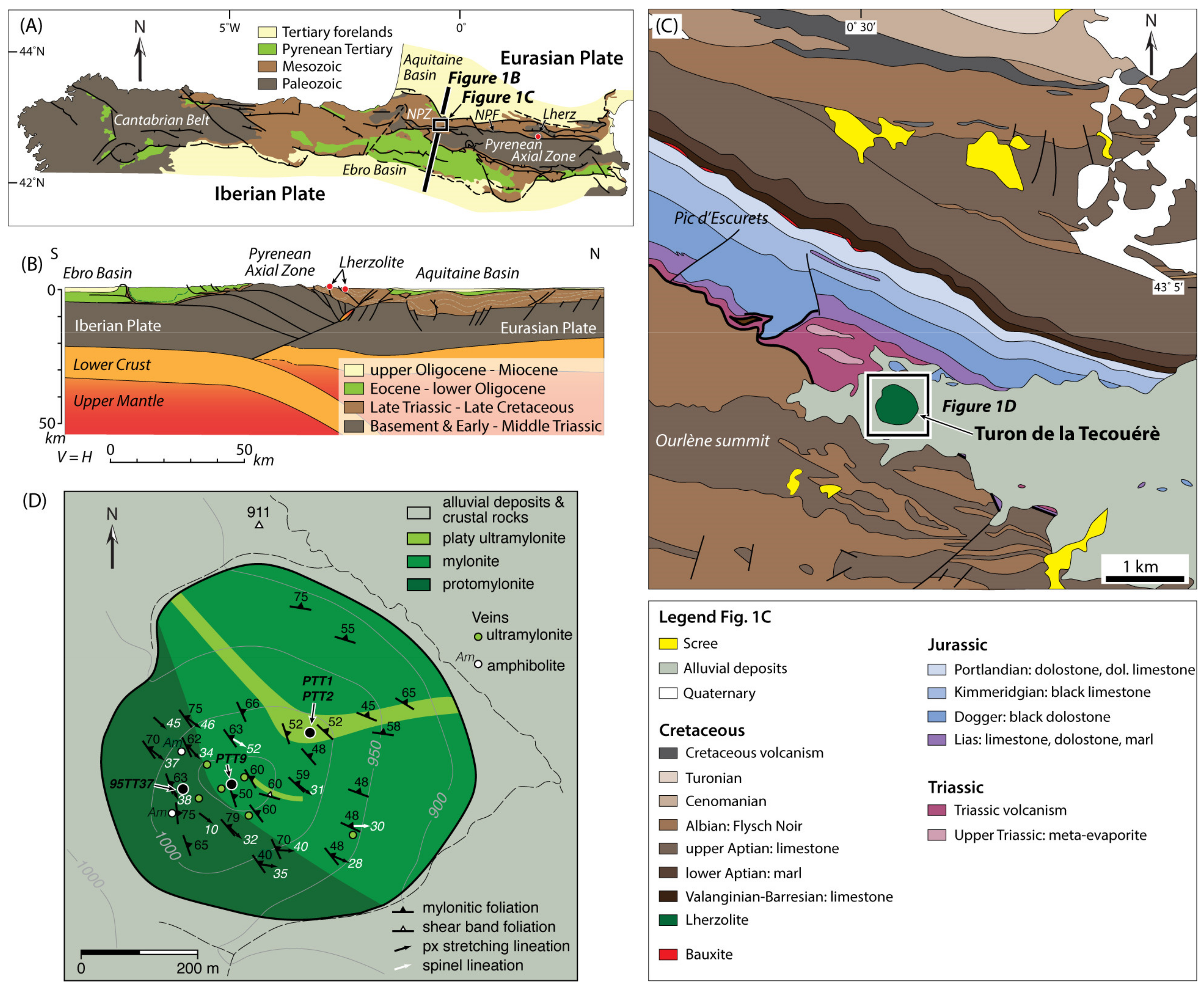
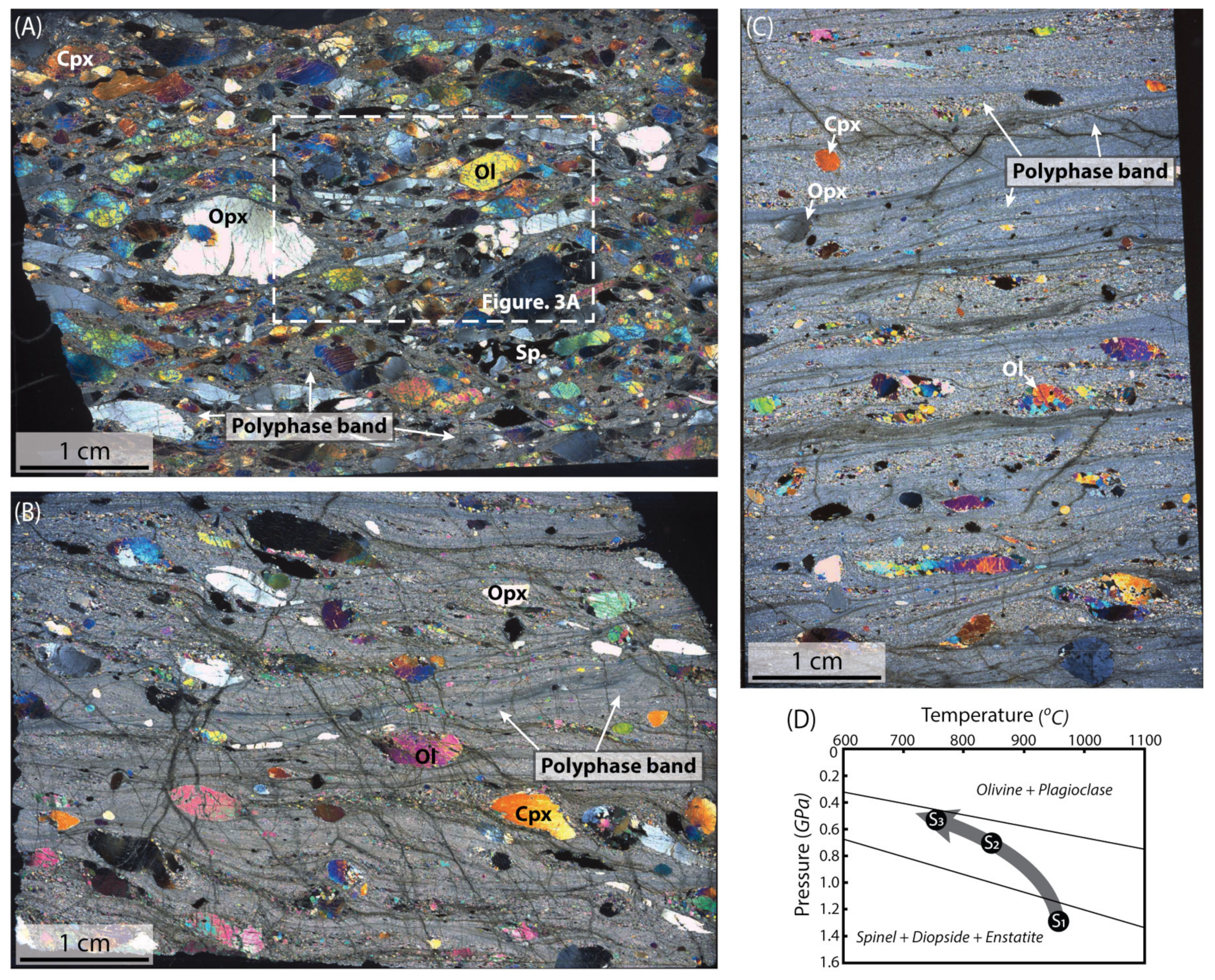
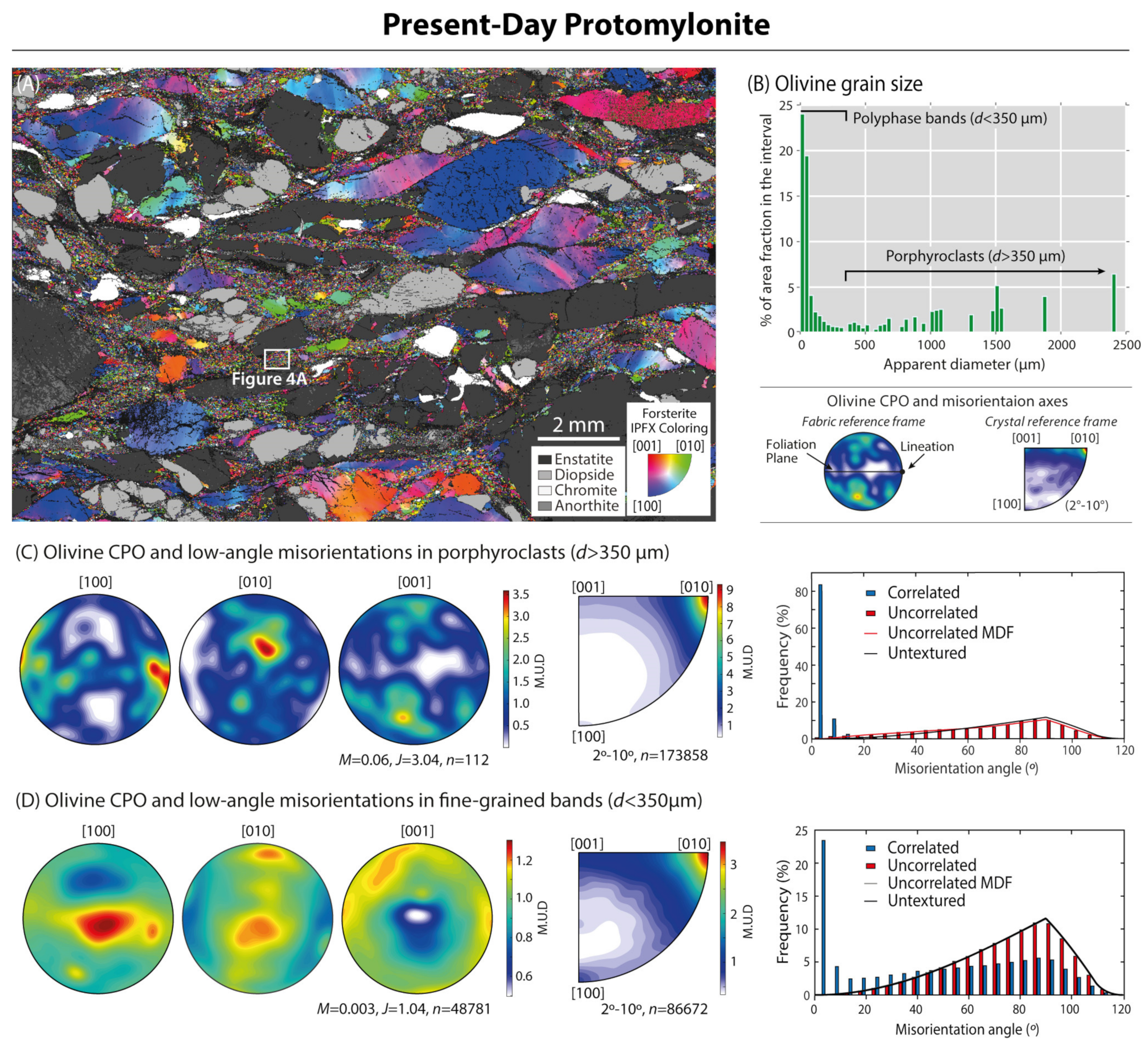
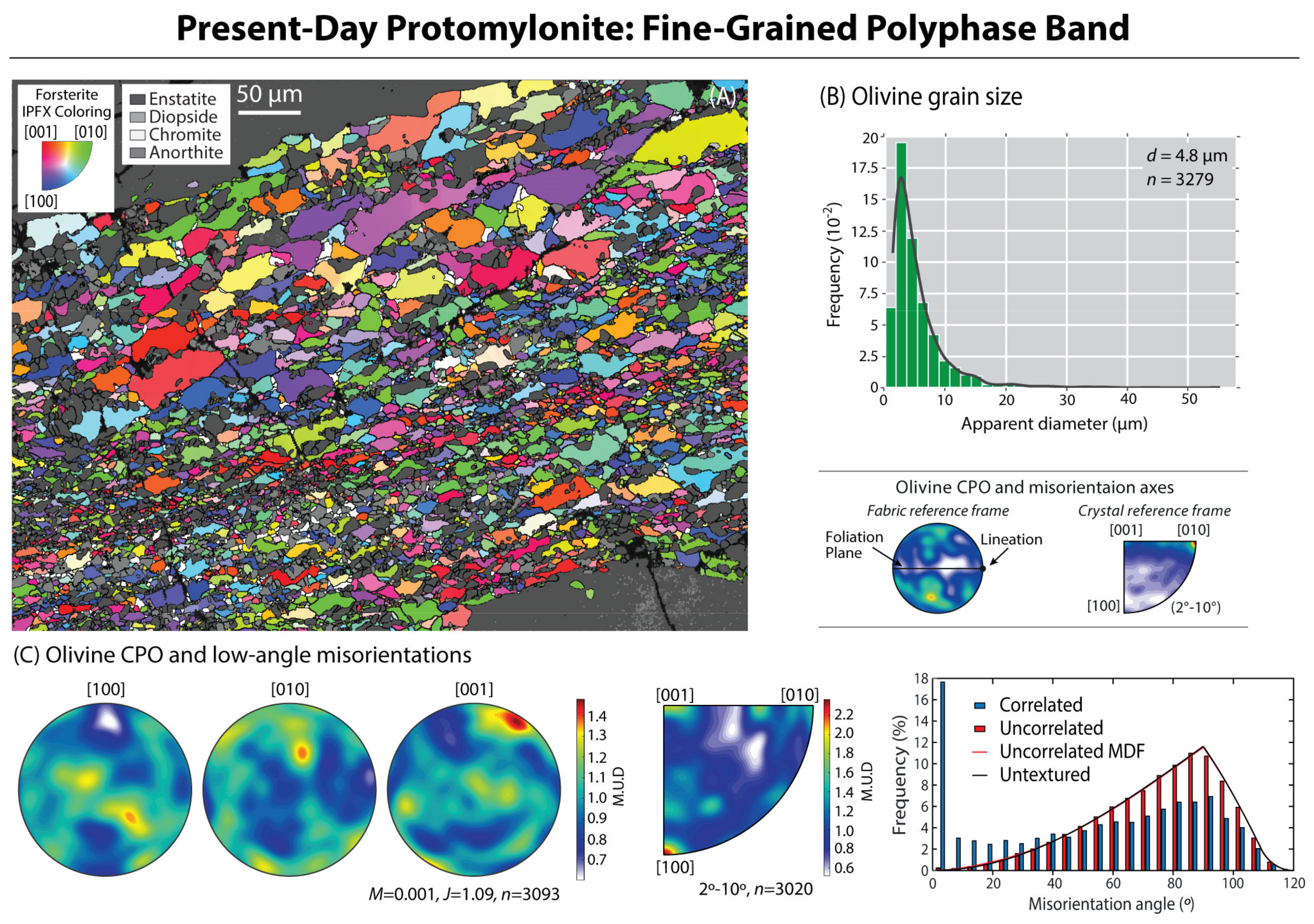
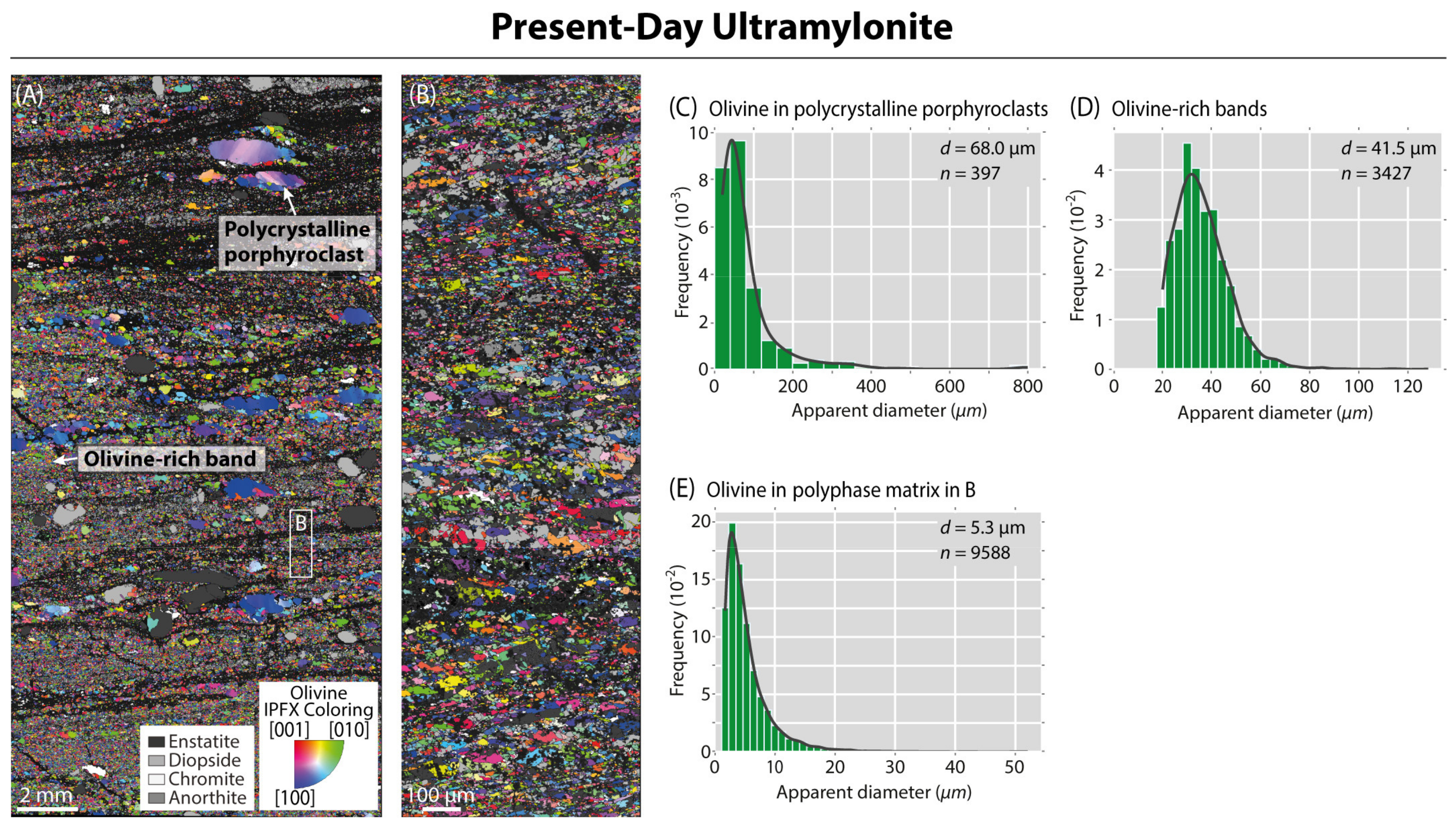
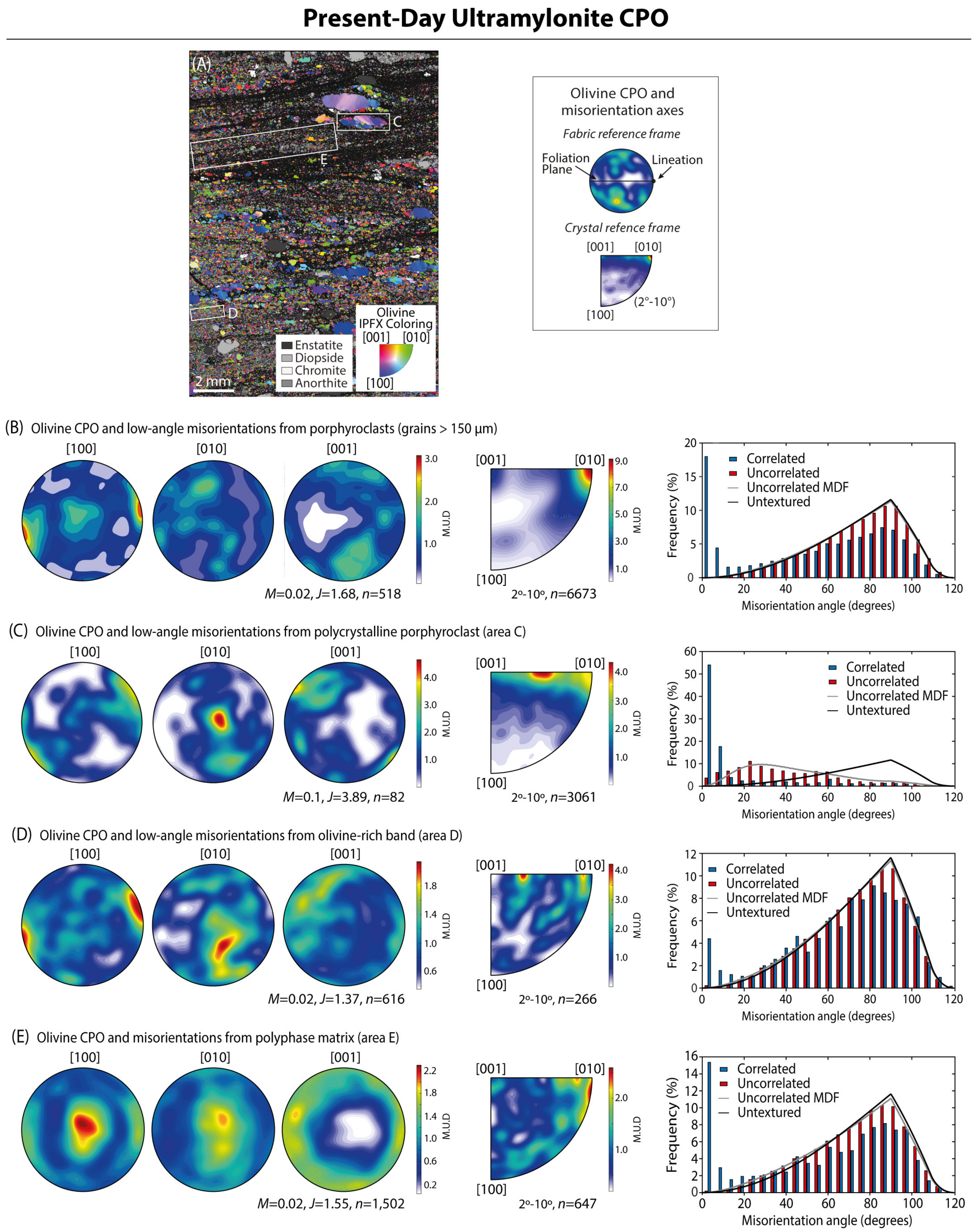
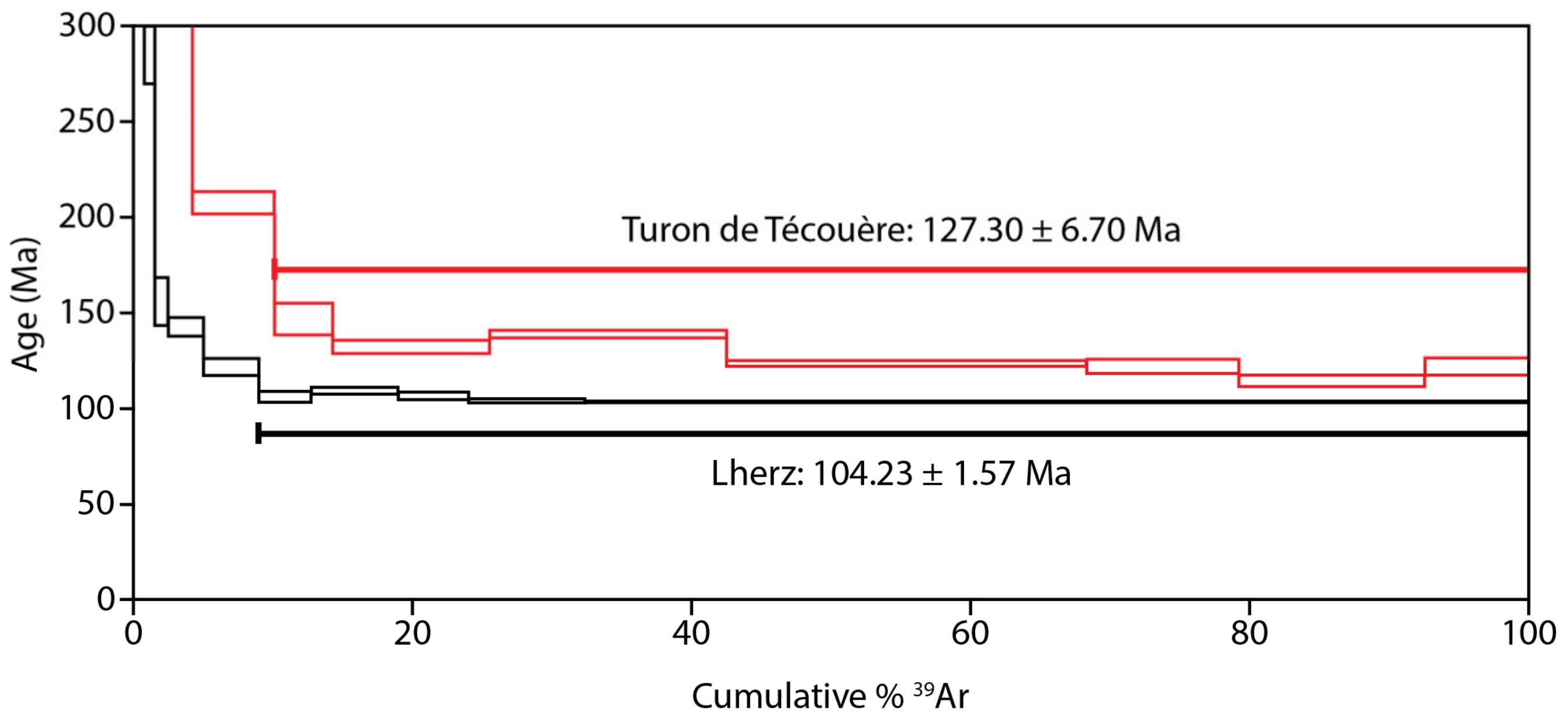
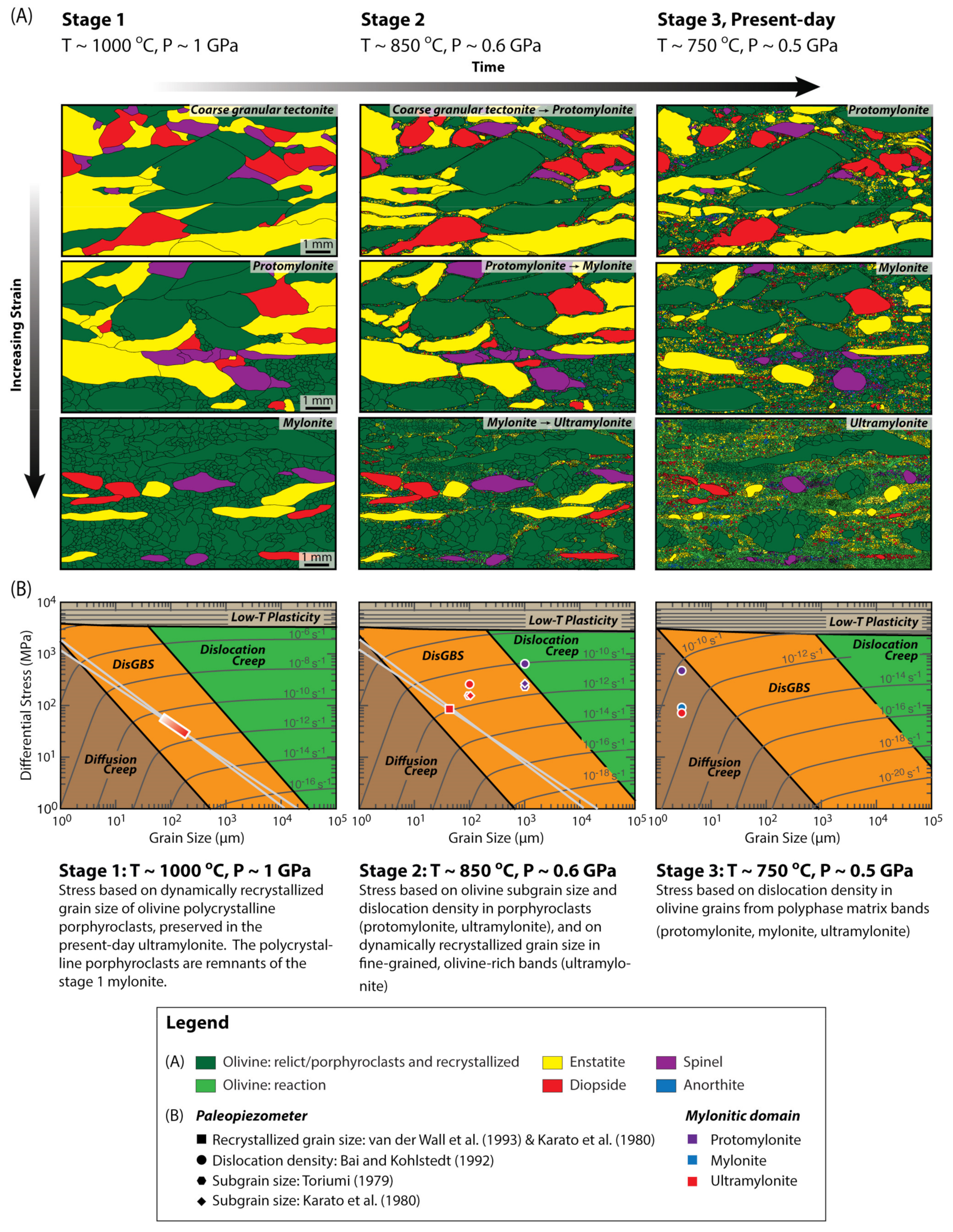
| Mylonite Type | Dislocation Density | Subgrain Size | Grain Size | ||||||
|---|---|---|---|---|---|---|---|---|---|
| Density (m2) | Stress (MPa) | N | dsg (μm) | Stress (MPa) | d (μm) | Stress (MPa) | |||
| BK92 | T79 | KTF80 | WCDG93 | KTF80 | |||||
| Protomylonite–95TT37 | |||||||||
| Porphyroclasts | 1.17 × 1013 | 634 | 1057 | 6.4 | 229 | 281 | 103 | - | - |
| Matrix | 8.21 × 1012 | 478 | - | - | - | - | 3.2 | - | - |
| Mylonite–PTT9 | |||||||||
| Porphyroclasts | 2.85 × 1012 | 226 | 304 | 8.7 | 168 | 176 | - | - | - |
| Matrix | 8.46 × 1011 | 89 | - | - | - | - | 3.3 | - | - |
| Ultramylonite–PTT1, PTT2 | |||||||||
| Porphyroclasts | 3.35 × 1012 | 250 | 217 | 9.5 | 154 | 156 | 102 | - | - |
| Polycrystalline porphyroclasts | - | - | - | - | - | - | 68 | 58 | 59 |
| Fine-grained olivine-matrix | - | - | - | - | - | - | 42 | 83 | 88 |
| Matrix | 6.77 × 1011 | 70 | - | - | - | - | 3.1 | - | - |
Publisher’s Note: MDPI stays neutral with regard to jurisdictional claims in published maps and institutional affiliations. |
© 2021 by the authors. Licensee MDPI, Basel, Switzerland. This article is an open access article distributed under the terms and conditions of the Creative Commons Attribution (CC BY) license (https://creativecommons.org/licenses/by/4.0/).
Share and Cite
Newman, J.; Chatzaras, V.; Tikoff, B.; Wijbrans, J.R.; Lamb, W.M.; Drury, M.R. Strain Localization at Constant Strain Rate and Changing Stress Conditions: Implications for Plate Boundary Processes in the Upper Mantle. Minerals 2021, 11, 1351. https://doi.org/10.3390/min11121351
Newman J, Chatzaras V, Tikoff B, Wijbrans JR, Lamb WM, Drury MR. Strain Localization at Constant Strain Rate and Changing Stress Conditions: Implications for Plate Boundary Processes in the Upper Mantle. Minerals. 2021; 11(12):1351. https://doi.org/10.3390/min11121351
Chicago/Turabian StyleNewman, Julie, Vasileios Chatzaras, Basil Tikoff, Jan R. Wijbrans, William M. Lamb, and Martyn R. Drury. 2021. "Strain Localization at Constant Strain Rate and Changing Stress Conditions: Implications for Plate Boundary Processes in the Upper Mantle" Minerals 11, no. 12: 1351. https://doi.org/10.3390/min11121351
APA StyleNewman, J., Chatzaras, V., Tikoff, B., Wijbrans, J. R., Lamb, W. M., & Drury, M. R. (2021). Strain Localization at Constant Strain Rate and Changing Stress Conditions: Implications for Plate Boundary Processes in the Upper Mantle. Minerals, 11(12), 1351. https://doi.org/10.3390/min11121351






